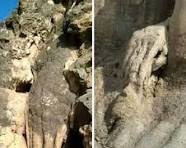The Science Behind the Stone
The human brain is remarkably adept at recognizing familiar patterns, even where none exist. This phenomenon, known as pareidolia, causes us to see faces in clouds, animals in rock formations, and yes—hands in stone. When combined with the right geological conditions, weathering patterns, and a touch of wishful thinking, ordinary rock formations can appear extraordinarily hand-like.
Notable Examples From Around the World
Wadi Rum, Jordan: Among the dramatic sandstone cliffs of this UNESCO World Heritage Site lies a large handprint formation that has puzzled visitors for generations. The origins of this marking remain debated—some believe it to be an ancient formation, while others suggest it could be a combination of natural weathering and human interpretation.
White Mountain, Wyoming: This hand-shaped rock formation has become a local legend in Wyoming. While many geologists consider it a natural feature formed by typical erosion processes, its striking appearance has made it a destination for curious visitors.
The Giant Connection: Mythology Meets Geology
The discovery of hand-shaped rock formations has inevitably led to speculation about their connection to ancient giant mythology. Cultures around the world have legends of giants. The Diné (Navajo) people tell stories of Yeitso, a fearsome monster giant that once terrorized their ancestors. Similar giant legends appear in Greek, Norse, Biblical, and countless other cultural traditions.
Why We Want to Believe
The appeal of petrified giant hands speaks to something deeper than simple curiosity. These formations represent the unknown past, human scale and humility, mystery in an explained world, and connection to mythology. They provide a potential physical link to the stories our ancestors told around campfires.
↑ Back to top

